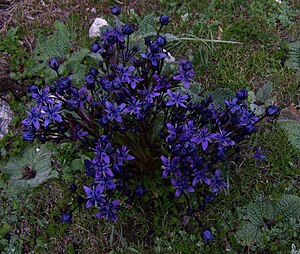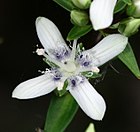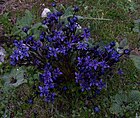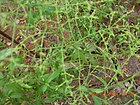Note: This is a project under development. The articles on this wiki are just being initiated and broadly incomplete. You can Help creating new pages.
Difference between revisions of "Swertia chirayita - chirayata"
(Created page with "{{stub}} ==Uses== ==Parts Used== ==Chemical Composition== ==Common names== ==Habit== ==Identification== ===Leaf=== ===Flower=== ===Fruit=== ===Other features=== ==List of Ayu...") |
(→List of Ayurvedic medicine in which the herb is used) |
||
| (10 intermediate revisions by 2 users not shown) | |||
| Line 1: | Line 1: | ||
| − | + | [[File:Whf blue 08.jpg|thumb|right|''Chirayita'']] | |
| + | '''Chirayita''' is a medicinal plant indigenous to temperate Himalaya. Chirayita has an erect, about 2–3 ft long stem, the middle portion is round, while the upper is four-angled, with a prominent decurrent line at each angle. | ||
==Uses== | ==Uses== | ||
| + | {{Uses|Stomach problems}}, {{Uses|Indigestion}}, {{Uses|Nausea}}, {{Uses|Bloating}}, {{Uses|Skin eruptions}}, {{Uses|Liver problems}}, {{Uses|Fever}}, {{Uses|Tuberculosis}}, {{Uses|Malaria}} | ||
| + | |||
==Parts Used== | ==Parts Used== | ||
| + | {{Parts Used|Whole herb}}. | ||
| + | |||
==Chemical Composition== | ==Chemical Composition== | ||
| + | The plant contains a bitter glycoside chiratin, which on hydrolysis yields two bitter principles: ophelic acid, an amorphous bitter hygroscopic principle, and chiratogenin, a yellow bitter glycoside, insoluble in water.<ref name="chemical composition"/> | ||
| + | |||
==Common names== | ==Common names== | ||
| + | {{Common names|kn=Nelabevu|ml=Kiriyatta, Kiriyattu|sa=Anaryatikta|ta=Nilavembu, Shirattakuchi|te=Nelavemu|hi=Chirayata, Charaita|en=Chirayita}} | ||
| + | |||
| + | ==Properties== | ||
| + | Reference: Dravya - Substance, Rasa - Taste, Guna - Qualities, Veerya - Potency, Vipaka - Post-digesion effect, Karma - Pharmacological activity, Prabhava - Therepeutics. | ||
| + | ===Dravya=== | ||
| + | |||
| + | ===Rasa=== | ||
| + | Tikta (Bitter) | ||
| + | ===Guna=== | ||
| + | Laghu (Light), Ruksha (Dry) | ||
| + | ===Veerya=== | ||
| + | Sheeta (cold) | ||
| + | ===Vipaka=== | ||
| + | Katu (Pungent) | ||
| + | ===Karma=== | ||
| + | Kapha, Vata | ||
| + | ===Prabhava=== | ||
| + | |||
==Habit== | ==Habit== | ||
| + | {{Habit|Herb}} | ||
| + | |||
==Identification== | ==Identification== | ||
===Leaf=== | ===Leaf=== | ||
| + | {{Leaf|Simple|Alternate|The leaves are divided into 3-6 toothed leaflets, with smaller leaflets in between}}<ref name="Leaf"/> | ||
| + | |||
===Flower=== | ===Flower=== | ||
| + | {{Flower|Unisexual|2-4cm long|Green-yellow|5-20|Flowers are small, stalked, green-yellow, tinged with purple colour}} | ||
| + | |||
===Fruit=== | ===Fruit=== | ||
| + | {{Fruit|General|7–10 mm|clearly grooved lengthwise, Lowest hooked hairs aligned towards crown||-}} | ||
| + | |||
===Other features=== | ===Other features=== | ||
| + | |||
==List of Ayurvedic medicine in which the herb is used== | ==List of Ayurvedic medicine in which the herb is used== | ||
| + | |||
==Where to get the saplings== | ==Where to get the saplings== | ||
==Mode of Propagation== | ==Mode of Propagation== | ||
| + | {{Propagation|Seeds}}. | ||
| + | |||
==How to plant/cultivate== | ==How to plant/cultivate== | ||
| + | Succeeds in a moist humus-rich soil in damp light woodlands, streamsides or the bog garden[200]. Grows best in areas with cool summerse<ref name="How to plant/cultivate"/> | ||
| + | |||
==Commonly seen growing in areas== | ==Commonly seen growing in areas== | ||
| + | {{Commonly seen|Pasture areas}}, {{Commonly seen|Slope areas of Himalayas}} | ||
| + | |||
==Photo Gallery== | ==Photo Gallery== | ||
| + | <gallery class="left" caption="" widths="140px" heights="140px"> | ||
| + | 8426-Swertia sp.-Gunung Kemiri.jpg | ||
| + | |||
| + | |||
| + | Whf blue 08.jpg | ||
| + | |||
| + | |||
| + | കിരിയാത്ത്(chiretta plant).JPG | ||
| + | |||
| + | |||
| + | കിരിയാത്ത്ചെടി.jpg | ||
| + | |||
| + | </gallery> | ||
| + | |||
==References== | ==References== | ||
| + | |||
| + | <references> | ||
| + | <ref name="chemical composition">[http://www.shergaonforests.org/2011/03/swertia-chirata.html "Chemical constituent"]</ref> | ||
| + | |||
| + | <ref name="Leaf">[https://www.flowersofindia.net/catalog/slides/Chirayita.html "plant decsription"]</ref> | ||
| + | |||
| + | <ref name="How to plant/cultivate">[https://www.pfaf.org/user/Plant.aspx?LatinName=Swertia+chirayita "Cultivation details"]</ref> | ||
| + | </references> | ||
| + | |||
==External Links== | ==External Links== | ||
| + | * [https://www.researchgate.net/publication/273704924_Swertia_Chirayita_Roxb_Ex_Flemming_Karsten_Cultivation_in_Nepal_Himalayas_Mini_Review Karsten Cultivation in Nepal Himalayas: Mini Review] | ||
| + | * [https://www.sciencedirect.com/science/article/pii/S0254629916341035 Swertia Chirayita on science direct] | ||
| + | * [https://www.ncbi.nlm.nih.gov/pmc/articles/PMC4709473/ A Review of Swertia chirayita (Gentianaceae) as a Traditional Medicinal Plant] | ||
| + | |||
[[Category:Herbs]] | [[Category:Herbs]] | ||
| + | [[Category:Ayurvedic herbs that don't have seed photos]] | ||
| + | [[Category:Gentianaceae]] | ||
Latest revision as of 15:15, 13 June 2019
Chirayita is a medicinal plant indigenous to temperate Himalaya. Chirayita has an erect, about 2–3 ft long stem, the middle portion is round, while the upper is four-angled, with a prominent decurrent line at each angle.
Contents
- 1 Uses
- 2 Parts Used
- 3 Chemical Composition
- 4 Common names
- 5 Properties
- 6 Habit
- 7 Identification
- 8 List of Ayurvedic medicine in which the herb is used
- 9 Where to get the saplings
- 10 Mode of Propagation
- 11 How to plant/cultivate
- 12 Commonly seen growing in areas
- 13 Photo Gallery
- 14 References
- 15 External Links
Uses
Stomach problems, Indigestion, Nausea, Bloating, Skin eruptions, Liver problems, Fever, Tuberculosis, Malaria
Parts Used
Chemical Composition
The plant contains a bitter glycoside chiratin, which on hydrolysis yields two bitter principles: ophelic acid, an amorphous bitter hygroscopic principle, and chiratogenin, a yellow bitter glycoside, insoluble in water.[1]
Common names
| Language | Common name |
|---|---|
| Kannada | Nelabevu |
| Hindi | Chirayata, Charaita |
| Malayalam | Kiriyatta, Kiriyattu |
| Tamil | Nilavembu, Shirattakuchi |
| Telugu | Nelavemu |
| Marathi | NA |
| Gujarathi | NA |
| Punjabi | NA |
| Kashmiri | NA |
| Sanskrit | Anaryatikta |
| English | Chirayita |
Properties
Reference: Dravya - Substance, Rasa - Taste, Guna - Qualities, Veerya - Potency, Vipaka - Post-digesion effect, Karma - Pharmacological activity, Prabhava - Therepeutics.
Dravya
Rasa
Tikta (Bitter)
Guna
Laghu (Light), Ruksha (Dry)
Veerya
Sheeta (cold)
Vipaka
Katu (Pungent)
Karma
Kapha, Vata
Prabhava
Habit
Identification
Leaf
| Kind | Shape | Feature |
|---|---|---|
| Simple | Alternate | The leaves are divided into 3-6 toothed leaflets, with smaller leaflets in between |
Flower
| Type | Size | Color and composition | Stamen | More information |
|---|---|---|---|---|
| Unisexual | 2-4cm long | Green-yellow | 5-20 | Flowers are small, stalked, green-yellow, tinged with purple colour |
Fruit
| Type | Size | Mass | Appearance | Seeds | More information |
|---|---|---|---|---|---|
| General | 7–10 mm | clearly grooved lengthwise, Lowest hooked hairs aligned towards crown | - | {{{6}}} |
Other features
List of Ayurvedic medicine in which the herb is used
Where to get the saplings
Mode of Propagation
How to plant/cultivate
Succeeds in a moist humus-rich soil in damp light woodlands, streamsides or the bog garden[200]. Grows best in areas with cool summerse[3]
Commonly seen growing in areas
Pasture areas, Slope areas of Himalayas
Photo Gallery
References
External Links
- Ayurvedic Herbs known to be helpful to treat Stomach problems
- Ayurvedic Herbs known to be helpful to treat Indigestion
- Ayurvedic Herbs known to be helpful to treat Nausea
- Ayurvedic Herbs known to be helpful to treat Bloating
- Ayurvedic Herbs known to be helpful to treat Skin eruptions
- Ayurvedic Herbs known to be helpful to treat Liver problems
- Ayurvedic Herbs known to be helpful to treat Fever
- Ayurvedic Herbs known to be helpful to treat Tuberculosis
- Ayurvedic Herbs known to be helpful to treat Malaria
- Herbs with Whole herb used in medicine
- Herbs with common name in Kannada
- Herbs with common name in Hindi
- Herbs with common name in Malayalam
- Herbs with common name in Tamil
- Herbs with common name in Telugu
- Herbs with common name in Sanskrit
- Herbs with common name in English
- Habit - Herb
- Index of Plants which can be propagated by Seeds
- Herbs that are commonly seen in the region of Pasture areas
- Herbs that are commonly seen in the region of Slope areas of Himalayas
- Herbs
- Ayurvedic herbs that don't have seed photos
- Gentianaceae




